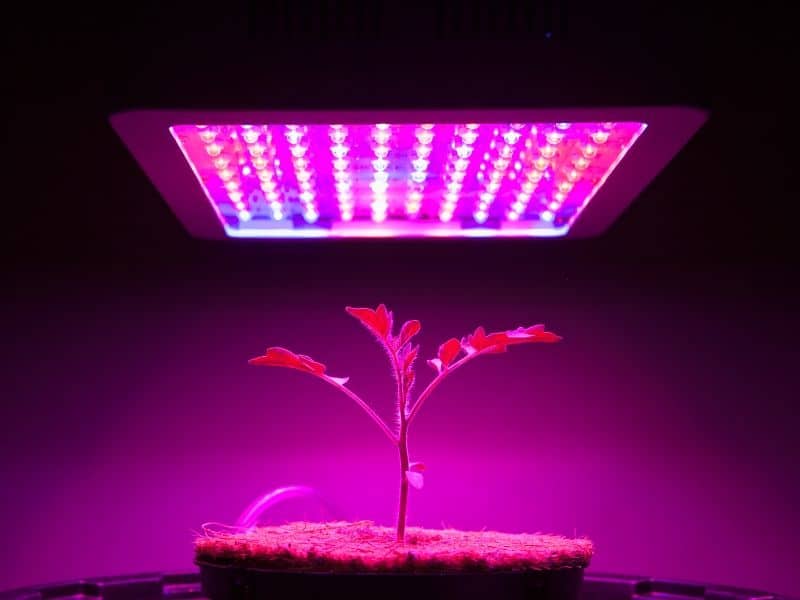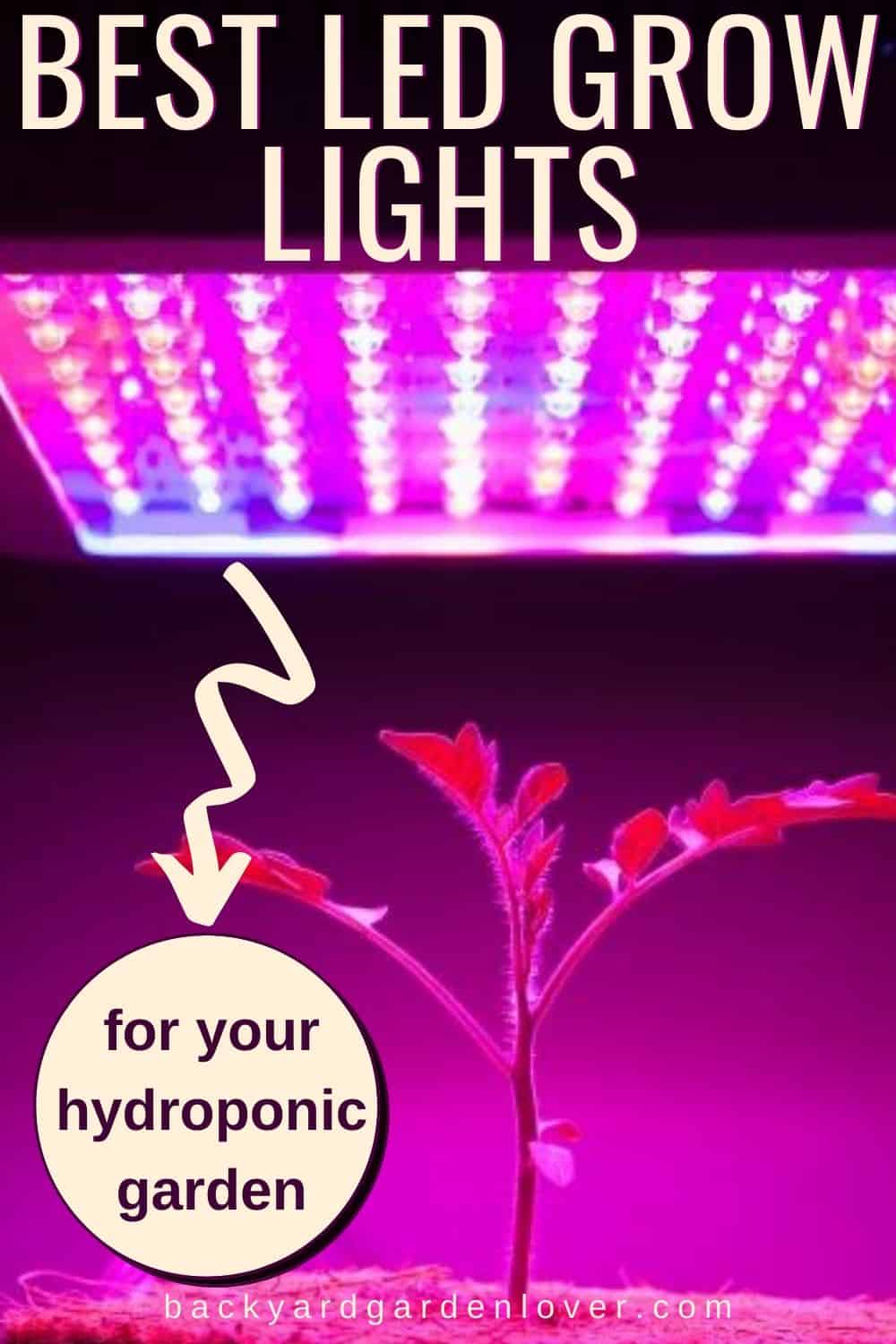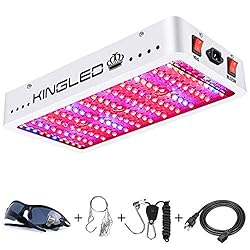LED technology has advanced significantly in the last 10 years. They are more efficient than ever. They give off less heat, costs are way down, and they can produce the full light spectrum needed for your plants. But which are the best LED grow lights for your hydroponic garden? Leep reading to learn more.

Looks cool, doesn’t it? Futuristic… a space odyssey…
L.E.D. stands for light-emitting diode. It’s a lighting technology that you probably have seen used for indicator lights on electronic devices, like clocks and stereos. It is now being used more and more for higher power applications, such as super-bright flashlights and area lighting… and for grow lights.
Best LED Grow Lights At A Glance
Note: This list is not exhaustive, but a good starting point for decision making. New and better products appear in the market regularly. Please do your own research before committing yourself to a specific light system.
If you are growing a few small plants like herbs, lettuce, tomatoes, and peppers, you can expect good results from:
- Socketed light bulbs
- Full-spectrum LED growing light for indoor plants
- Derlights® 40W Equivalent E27 Full Spectrum Plant Grow Bulb, SMD2835
LED Arrays – For lettuce rafts and larger grows
KUKUPPO 600W LED Grow Light Full Spectrum for Indoor Plants Veg and Flower. Hydroponics Plant Growing Light Fixtures with Daisy Chain Function & Powerful Cooling Fans Phlizon 600W LED Plant Grow Light, with Thermometer Humidity Monitor, Adjustable Rope, Full Spectrum Double Switch Plant Light for Indoor Plants Veg & Flower
Phlizon 600W LED Plant Grow Light, with Thermometer Humidity Monitor, Adjustable Rope, Full Spectrum Double Switch Plant Light for Indoor Plants Veg & Flower VIPARSPECTRA UL Certified 450W LED Grow Light, with Daisy Chain, Veg and Bloom Switches, Full Spectrum Plant Growing Lights for Indoor Plants Veg & Flower
VIPARSPECTRA UL Certified 450W LED Grow Light, with Daisy Chain, Veg and Bloom Switches, Full Spectrum Plant Growing Lights for Indoor Plants Veg & Flower King Plus 1200w LED Grow Light Full Spectrum for Greenhouse Indoor Plant Veg & Flower(Dual-chip 10w LEDs)
King Plus 1200w LED Grow Light Full Spectrum for Greenhouse Indoor Plant Veg & Flower(Dual-chip 10w LEDs) Roleadro Grow Light, 1000W LED Grow Light Full Spectrum Galaxyhydro Series Plant Light for Indoor Plants with UV&IR for Greenhouse, Hydroponics
Roleadro Grow Light, 1000W LED Grow Light Full Spectrum Galaxyhydro Series Plant Light for Indoor Plants with UV&IR for Greenhouse, Hydroponics Apollo Horticulture GL80LED Full Spectrum 240W LED Grow Light for Indoor Plant Growing
Apollo Horticulture GL80LED Full Spectrum 240W LED Grow Light for Indoor Plant Growing
LED Configurations
Depending on the specific configuration, LEDs come in two basic packages. Most of us are familiar with the incandescent replacement bulbs for the home. Growers use socketed multi-led, spotlight type bulbs of up to 100 watts for single plants – I use them to grow dwarf tomato plants. The rectangular-shaped fixtures hold many LEDs and produce into the hundreds of watts which can be used for larger systems like lettuce rafts. The larger LED fixtures usually include a small internal cooling fan for higher efficiency. These fans are nowhere near the size of that required for comparable HIDs.
The full spectrum
Most growers use HIDs early in the grow cycle, and switch to an HPS bulb as the plants mature. LED grow lights on the other hand provide a huge spectrum of energy. Because of this, when you use LEDs, you don’t have to be bothered by switching out lights as your crops mature. With LEDs, you can actually install a system that’s tailored specifically to the type of crop you grow. If you really want the control, some LED systems allow you to change the spectrum delivered by simply dialing a switch.
Smaller space requirements
LEDs require much less space than HIDs, so you can use them in more confined grow areas. Smaller size, cooler temperatures mean that you can put your lights much closer to your plants without the risk of burning them. Depending on the crop and the wattage of your LEDs, you should ensure that there is between 4” and 18” between the light and the plants. HIDs are usually kept several feet away from the plants.
Are LED grow lights for you?

Here’s the lowdown on LED lighting for hydroponics gardening…
LEDs have some really attractive advantages… They are very cool and do not create the excessive heat that HID lighting does.
They consume less than half the electricity of the traditional lighting, and the bulbs last for many years. But you must replace HID bulbs every year or two.
Be aware that there is a lot of cheap LED garbage out there that won’t grow any better than a $12 lightstick from Walmart.
On the other hand, some quality LED lighting setups had produced not only adequate but impressive results with vegetative, flowering, and even fruiting of vegetables. So we encourage you to consider LED lighting for your home hydroponics set up.
Advantages of LED lights
Lower cost
Because of the lower heat factor, LEDs can be placed a great deal closer to the plants than can HIDs. This reduces dramatically (rule of inverse squares) the wattage required to deliver the necessary energy to the plants.
The cost to operate LEDs is negligible compared to HIDs because of the much lower wattage required per square foot of plantings and of course the low power consumption of LEDs.
The initial cost for LEDs is now somewhat lower than HIDs, and getting better all the time. The lifespan is much greater as LED grow lights typically last for 50,000 hours or more, whereas HID bulbs generally last only 10,000 to 18,000 hours, giving an even lower total cost per hour of operation.
A big advantage of LEDs over HID lighting is the heat factor. For most LED installations you will not need extra fans, while HIDs require ventilation for the lights, and may also require ventilation for the growing area. LEDs give fairly significant savings in electrical costs.
Popular with hobbyists
LEDs are very popular with hobbyists and small growers, especially those limited to only a few plants or a small space. LEDs are compact, quiet, lightweight, and do not usually require ventilation. Whereas HIDs are heavier, require external ballasts and ventilation, which can be quite noisy. This makes LEDs ideal for the in-home hobbyist installations.
Disadvantages of LED Grow Lights
Nothing is perfect, and neither are LEDs. Keep in mind that LED technology is advancing in leaps and bounds. A disadvantage today could be overcome tomorrow. As with any new technology, LED manufacturers are not agreed upon common standards and measures, so you run the risk of not getting what you thought was advertised.
LEDs for growers are reviewed regularly by big and small growers and suppliers. Check their websites and YouTube channels for the latest reviews of LED technology. YouTube regularly features reviews of the latest in LEDs for the hobbyist.
Less powerful
HID lights were much more powerful than LEDs, but this is changing. Power is important as the more power a light delivers, the more intense the light, and thus greater chance of complete nourishment for the entire garden.
Constant height adjustment
Because LEDs have lower power and are kept closer to the plants, they must be raised regularly to keep from burning the plants. The grower must take care that the plants do not touch the lights, as this will kill the affected part.
Most small growers have no problem with this ritual. I have my LEDs suspended by their cords and just shorten them as required.
Harmful rays
LEDs provide your crops with a great deal of light from the blue end of the spectrum. This is great, particularly when your plants are in the vegetative stage. Unfortunately for the grower, long term exposure to blue light can damage your retinal cells (similar to ultraviolet damage).
This should not be a problem in a separate grow area but can cause difficulties in an in-home installation, especially if your system is in a living area also.
Light burn
Because of the proximity to the plants, LED users risk light burn (as opposed to heat burn) which can severely damage the crop. Light burn will turn leaves yellow and then white. Without color, the plant leaves cannot carry on photosynthesis, and eventually, the plant has nothing to offer your consumers.
Light penetration
LEDs do not have quite the penetration through the plant canopy as HIDs. The diodes deliver light at a 90° angle and do not diffuse significantly around the sides and undersides of the plant. However, this can be much improved with reflective materials like foil, mylar, reflectix, or titanium white paint for the walls.
Choosing Led Grow Lights
There are three types of LED grow lights on the market today.
Cheap in every sense of the word
Do not choose based on price alone! Go online to eBay, or Google “LED grow lights” and you will be stunned by the array of inexpensive LED light bulbs hawked as suitable for growing crops indoors. The LEDs we’re talking about here give very little information about PAR levels, spectrum information, or actual wattage draw.
They are usually round, with cheap plastic frames, called UFOs, do not have fans, and each diode or chip is usually only one watt. They are blue and red in color and sell for between $50 and $200 each.
Don’t waste your money! Most of these are cheap knockoffs and do not contain the proper spectrums for serious hydroponics gardens. The diodes usually dim and burn out quickly. We have recommended one light in this range because we have used it, are pleased with it, and it has exceptional reviews elsewhere.
Middle of the road
Moderately priced LED panels are usually specified as banded units, like 5-band, 7-band, and so on. What this means is they cover several spectrums in the growth cycle of plants, and can be quite effective for supporting your hydroponic crops from seedling to fruit.
These units usually have three-watt or five-watt diodes, cost between $300 and $700 (depending upon wattage), and last five to seven years or even longer without failing. They can have red and blue diodes, most have cooling fans, and are often called BROAD SPECTRUM lights.
We do recommend some of these lights at this time but read the reviews before you buy them.
CF GROW 540W COB LED Plant Grow Lamp for Indoor Plants, Plant Growing Light Lamp Panel COB LED Grow Light Full Spectrum 360W Ultra-Thin No Fan No Noise
COB LED Grow Light Full Spectrum 360W Ultra-Thin No Fan No Noise
The Best LEDs
The newest generation LED grow lights will satisfy even the serious grower. These lamps are truly the highest technology. They will produce the same yield as an HPS or MH light, with an average of 40% less energy usage.
These babies deliver all the spectra! Is that a word? 🙂 Anyway, the high end LED lamps have had rave reviews. If you want to buy the best, go with one of these.
HLG 550 V2 Rspec 500w 120 Volt- Horticulture Lighting Group Quantum Board LED Grow Light 4000 LED Grow Light 5×5 ft Flower Compatible with Samsung LM301B Diodes Dimmable Grow Lights for Indoor Plants Commercial Full Spectrum
4000 LED Grow Light 5×5 ft Flower Compatible with Samsung LM301B Diodes Dimmable Grow Lights for Indoor Plants Commercial Full Spectrum  Black Dog LED PhytoMAX-2 200 | LED Grow Lights | High Yield Full Spectrum Indoor Grow Light with Bonus Quick Start Guide
Black Dog LED PhytoMAX-2 200 | LED Grow Lights | High Yield Full Spectrum Indoor Grow Light with Bonus Quick Start Guide
California Lightworks Solar Systems are one of the best hydroponic systems available today. With the Solar System Controller, you can adjust each of the three separate light spectrum channels from 0% to 99%. This can be done manually or automatically using the built-in timer and calendar.
All California Lightworks LED’s are produced entirely in their factory in Southern California. Did you catch that? These are NOT Chinese imports!
5-year guarantee and friendly US-based support.
California Lightworks Solar System 1100 Premium Package – Commercial LED Grow Light Fixture. Accessories Included: LED Glasses, Grow Crew Ratchet Hangers, Legalize Tomatoes Sticker California Lightworks Solar System Controller for SolarSystem 550 LED fixture 24-hour Week by Week Timer, Automated Sunrise/Sunset, Veg/Bloom and Seasonal Program
California Lightworks Solar System Controller for SolarSystem 550 LED fixture 24-hour Week by Week Timer, Automated Sunrise/Sunset, Veg/Bloom and Seasonal Program
Well, that’s our compact synopsis and recommendations for new LED grow lights.
Please drop us a line and let us know how your LED project went. We appreciate your feedback and it’ll help us keep this page on the cutting edge for other growers.
Return from LED grow lights to hydroponic lights.
















20 Best Cherry Tomatoes To Grow In Your Garden
Tuesday 20th of June 2023
[…] seedlings in a sunny spot, providing them with at least 6 hours of sunlight each day. You can also use a grow light to ensure proper light exposure. Remember to rotate the seedlings to ensure even […]
How To Make Tomato Plants Grow Faster - 13 Easy Tips
Tuesday 20th of June 2023
[…] your tomato seeds early so you can reap the rewards sooner! Use modern tools like LED grow lights to give them a head start and get those juicy fruits […]
The Perfect Bonsai Accessories For Your Bonsai Tree
Tuesday 3rd of January 2023
[…] Learn more about grow lights. […]
21 Best Indoor Plants For Filtered Light
Tuesday 8th of June 2021
[…] you can always get grow lights or take potted plants outside during the day for more sun, that can be too much maintenance for […]
Easy DIY PVC Hydroponics Stand - Clever Design & Cheap To Build
Monday 15th of February 2021
[…] crops, The HydroPad® stand provides not only a sturdy base of operations, but it also holds the grow lights at any height, and as high up as possible to allow optimal space for vining crops (no holes in your […]